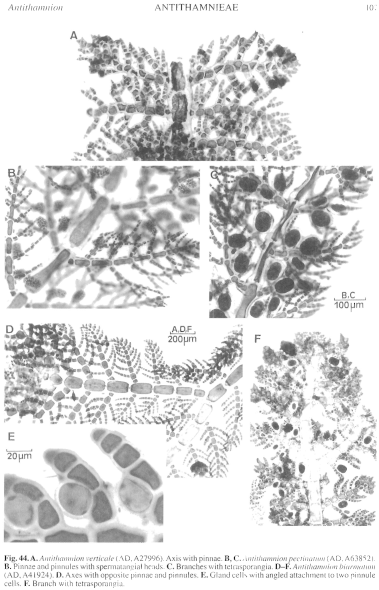|
|
|
|
|
|||||||||||
|
Electronic Flora of South Australia Species Fact Sheet
Phylum Rhodophyta – Order Ceramiales – Family Ceramiaceae – Tribe Antithamnieae
Thallus (Fig. 44D) red-brown, with prostrate axes bearing erect axes 2–15 mm long, complanately branched with opposite, distichous, whorl-branchlets (pinnae) from each axial cell. Attachment by much branched rhizoidal clusters from basal cells of pinnae; epiphytic. Structure. Apical cells 8–11 µm in diameter and L/D 1–1.5, enlarging rapidly and to 120–250 µm in diameter and L/D 1.5–2 in mature axial cells. Pinnae (350–) 500–800 µm and 10–15 >cells long, rachis cells (apart from the basal) each with opposite, distichous, pinnules (Fig. 44D) becoming 120–160 µm and 4–7 cells long; rachis cells 35–55 (–80) µm in diameter and L/D (1–) 1.2–1.7, the basal cell shorter, tapering to subterminal cells 15–20 µm in diameter and L/D 0.8–1.2, terminal cells with rounded ends; pinnule cells 20–28 µm in diameter and L/D 1–1.2; gland cells (Fig. 44E) single (–2) on the upper side of reduced or normal pinnules, in contact with 2 bearing cells with the common wall angled, 25–35 µm in diameter. Cells uninucleate; rhodoplasts discoid in small cells, ribbon like in larger cells.
Reproduction: Gametophytes dioecious. Carpogonial branches not observed. Carposporophytes with 1–3 rounded gonimolobes 150–450 µm across, with ovoid to angular carposporangia 30–60 µm across, without any involucral branchlets. Spermatangial heads borne on upper side of pinnule cells, elongate-ovoid, 25–35 µm in diameter and 40–80 µm long, with 5–7 axial cells each with several initials cutting off outer spermatangia.
Tetrasporangia (Fig. 44F) borne on lower pinnule cells, sessile, ovoid, 70–90 µm in diameter, decussately divided.
Type from Split Rock, Bicheno, Tas., on Codium harveyi, 20–22 m deep (Kraft 9387, 18.xii.1992); holotype in GB, isotype in MELU.
Selected specimens: Gabo I., Vic., on Plocamium costatum, 18 m deep (Shepherd, 17.ii.1973; AD, A43509). Bicheno, Tas., in kelp, 18–20 m deep (Kraft, 18.xii.1992; MELU, 40425). Fluted Cape, Bruny I., Tas., on Hymenena(?), 23 m deep (Shepherd, 12.ii.1972; AD, A41924) and on Polyopes constrictus, 16 m deep (Shepherd, 10.ii.1972; AD, A41515).
Distribution: SE Tasmania and Gabo I., Victoria.
References:
ATHANASIADIS, A. (1996). Morphology and classification of the Ceramioideae (Rhodophyta) based on phylogenetic principles. Opera Botanica No. 128, pp. 1–216.
The Marine Benthic Flora of Southern Australia Part IIIC complete list of references.
Publication:
Womersley, H.B.S. (24 December, 1998)
The Marine Benthic Flora of Southern Australia
Rhodophyta. Part IIIC. Ceramiales – Ceramiaceae, Dasyaceae
©State Herbarium of South Australia, Government of South Australia
Illustration in Womersley Part IIIA, 1998: FIG. 44 D–F.

Figure 44 enlarge
Fig. 44. A. Antithamnion verticals (AD, A27996). Axis with pinnae. B, C. Antithamnion pectinatum (AD, A63852). B. Pinnae and pinnules with spermatangial heads. C. Branches with tetrasporangia. D–F. Antithamnion biarmatum (AD, A41924). D. Axes with opposite pinnae and pinnules. E. Gland cells with angled attachment to two pinnule cells. F. Branch with tetrasporangia.

|
Email Contact: State Herbarium of South Australia |

|